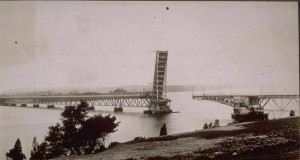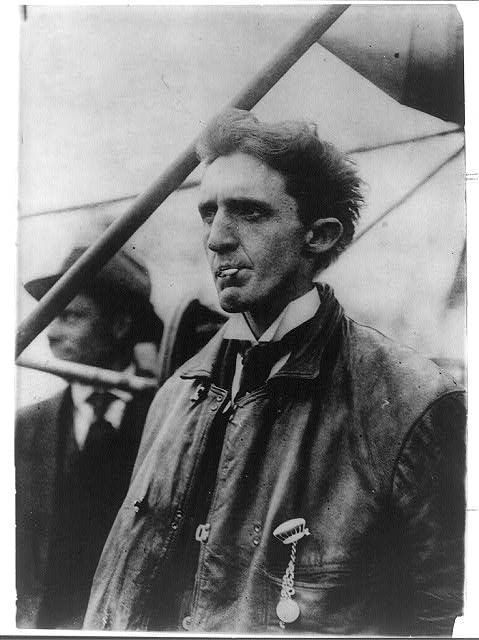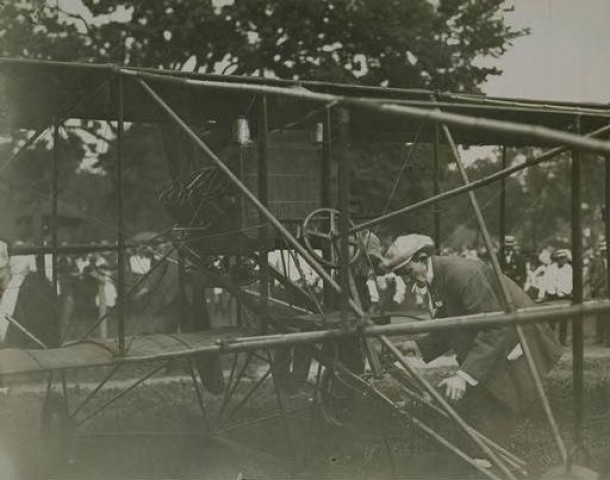By Tedd Levy for the Shoreline Times
Dedicating the first bridge between Saybrook and Old Lyme across the Connecticut River was cause for a spectacular celebration that attracted thousands of visitors and 500 new-fangled horseless carriages that traveled over the bridge and back in 1911. They came by special train from Hartford, on the Shore Line Electric Railway, in horse-drawn carriages, and two daring young men came by air to help commemorate the special occasion.

Connecticut River highway bridge (Saybrook-Old Lyme) – Mystic Seaport and Connecticut History Online
For people who never saw an aero plane lift off the ground into the sky, the chance to witness such an event was not to be missed. For thousands of years, human beings dreamed of the idea of flying like a bird. Now, as part of the ceremonies surrounding the remarkable new bridge, locals and visitors could also see a demonstration of this amazing new flying machine.
Nels J. Nelson, a 22-year-old Swedish immigrant working as an automobile mechanic in his shop on Elm Street in New Britain, began building and flying his own aircraft. On May 1, 1911, young Nelson made his first flight from the new field in Plainville, now known as Robertson Airport and the oldest in Connecticut.
That summer he flew some 40 miles to the ball field that also served as an airfield in Saybrook. Located at the end of Dudley and Coulter Streets, the area remained open fields until housing was built there in the 1940s. After arriving, he tested his biplane but it did not rise more than a few feet from the ground.
That evening a crowd of about 2,000 people gathered to see his flying machine and to watch the Saybrook and Deep River baseball game. When the time came, he took his machine to one end of the field, got good speed on the ground and, it was reported, “glided upward like a bird.”
He skillfully circled around while ascending to the magnificent height of two or three hundred feet. While circling, the engine’s radiator cap flew back and broke the wooden propeller. With the loss of thrust the aircraft came down rapidly and struck a fence as it landed. He was in the air for about five minutes.
Nelson continued to fly and build airplanes but, unable to get government contracts, ultimately lost out to other manufacturers. He died at his home in Yonkers, New york, in 1964.

Charles K. Hamilton, ca. 1910 – Library of Congress, Prints and Photographs Division
Charles K. Hamilton, of New Britain, also flew to Saybrook in the summer of 1911. He learned to fly from the noted Glenn Curtiss. Hamilton started as a daredevil of the air floating in hot-air balloons and parachute jumping at circuses and fairs. He made the first public flight in Connecticut, which was witnessed by an estimated 50,000 people in New Britain. Soon New Britain and Bridgeport became the centers of aviation in the State.
Hamilton was soon doing daring flight exhibitions that made him the best-known flyer in America. One of his first and very successful stunts was to climb to some 1,500 feet above the exhibition ground and cut his engine. Then he would dive steeply, pull out and land. Spectators marveled at his daring and thought he was diving to his own destruction.
Hamilton made a great deal of money from his stunts, some years as much as $100,000. On some occasions he received as much as $10,000 for two or three 10 to 15-minute flights. His aviation career was spectacular but sadly cut short when he died in 1914 at age 28 from tuberculosis. He is buried in Hartford’s Cedar Hill Cemetery.
Tedd Levy is a prolific author as well as a former teacher and past president of the National Council for the Social Studies. This article first appeared in the Shoreline Times (August 12, 2011).
Note: ConnecticutHistory.org does not edit content originally published on another platform and therefore does not update any instances of outdated content or language.









